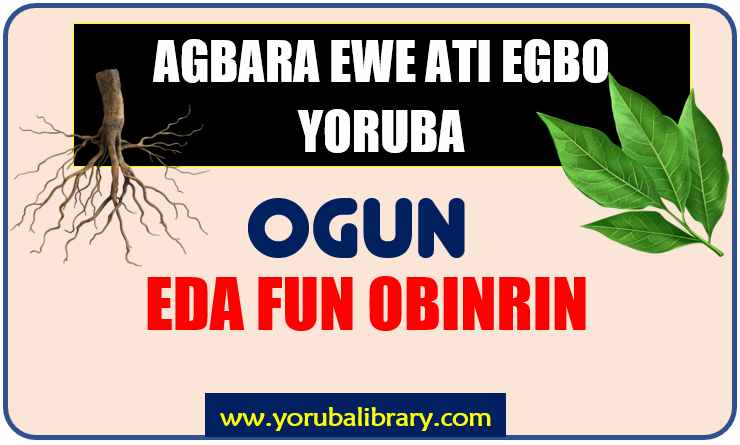
support@yorubalibrary.com
+2348073529208, 07038599574

In Yoruba thought, fertility is more than just a biological function; it is a function tied to destiny and family continuity. When a woman struggles with conception, the community often challenge requiring attention. One common ailment recognized by Yoruba elders is Èdà, described as sperm leakage from the womb after intercourse. This condition is believed to prevent a woman from conceiving, regardless of how many times she tries.
Yoruba tradition classifies Èdà into two main types:
• Èdà Ibule — Leakage that happens immediately when the woman lies down.
• Èdà Oro — Leakage that occurs after some time, even when she has already moved about.
To address this, our forefathers developed Ogun Èdà, a system of herbal remedies designed to strengthen the womb, “seal” it against leakage, and restore the woman’s reproductive balance. Ogun Èdà was never seen as mere medicine; it was a cure to safeguard, requiring correct herbs. For time immemorial, this practice allowed many women to overcome infertility challenges in times when hospitals and modern gynecology were unavailable. Even today, many families turn to these remedies for their potencies in treating Eda (sperm leakages).
For time immemorial, this practice allowed many women to overcome infertility challenges in times when hospitals and modern gynecology were unavailable. Even today, many families turn to these remedies for their potencies in treating Eda (sperm leakages).
Disclaimer
Yoruba Library and its Team will not be held liable for improper usage or any loss arising from improper use, wrong application, inability to find needed materials, or misinterpretation of this article. This article is provided strictly for guidance and educational purposes.
Symptoms Linked to Èdà (Sperm Leakage)
Yoruba elders and traditional healers observed certain patterns that suggested a woman might be suffering from Èdà:
• Continuous leakage of sperm immediately after intercourse.
• Watery or weak vaginal discharge following sexual relations.
• Inability to conceive despite frequent and regular marital intimacy.
• Womb weakness manifesting as inability to retain semen.
• Persistent anxiety about conception despite physical health.
• Emotional strain within the marriage due to delay in childbirth.
• Repeated frustration and worry leading to spiritual consultation.
How Our Forefathers Treated Èdà in the Past
When a woman was diagnosed with Èdà, Yoruba healers applied both a couple of methods. These included:
1) Herbal medicine to strengthen the womb and seal leakage.
2) Topical applications of selected leaves or roots around the lower abdomen.
3) Special cleansing baths to remove blockages and restore balance.
Below is the list of Yoruba roots and herbs which have been previously used in treatment of Eda in women:
(i) Ewe Abiwere
(ii) Ewe Odundun
(iii) Ewe Iyeye
(iv) Ewe Osibata
(v) Egbo Bomu Bomu
(vi) Egbo Akoko
(vii) Ewe Agunmaniye
Have you heard of Yoruba Herb Dictionary? This contains names of Yoruba Leaf, Roots, Barks, Characteristics, Properties & Identification with HD Pictures. Order below or download sample here
A-Z HERBS & LEAF DICTIONARY #4KOne Yoruba proverb says "Bí olóde ò kú, òde rè kì í wu Gbégi". Do you know that Gbégi is actually a leaf/plant? Get Yoruba Proverbs on Plants and Herbs, which is a collection of Untold Wisdoms Hidden in Leaf and plants comprising their Life Applications & Moral Teachings. Order below or download sample here
YORUBA PROVERBS ON PLANTS #4KThe Healing Process in Traditional Practice
Preparation of Ogun Ẹ̀dà was never rushed but followed steps to ensure potency:
(a) Collection of herbs and roots at dawn, a time believed to hold purity and fertility energy.
(b) Grinding and mixing into powder or medicine, depending on the selected method.
(c) First administration tested in small quantities before full application.
(d) Lifestyle adjustments such as abstaining from certain foods or heavy work were often advised.
Differences Between Yoruba and Modern Infertility Treatment
Focus of Healing — Yoruba methods treat the womb, body, while modern medicine targets hormonal, surgical, or assisted reproductive solutions.
• Materials Used — Yoruba remedies rely on leaves, bark, and roots; modern medicine depends on drugs, injections, or IVF.
• Approach to Continuity — Yoruba practice emphasizes one-time strengthening and spiritual cleansing, while modern medicine often requires repeated medical interventions.
Safety First: Important Contraindications and Considerations
1) Pregnancy — This remedy is not for women already pregnant.
2) Underlying Health Issues — Women with severe infections or complications must seek hospital care.
3) Source of Herbs — Only natural, untampered sources are trusted; polluted herbs are harmful.
Needed Materials (Leaves, Roots, Bark, etc.)
The medicinal approach for this requires careful selection of natural materials traditionally known to our elders. These are combined to ensure potency.
The instruction you will receive is the original account of our forefathers, preserved and tested over time. Many people have used them with testimonies of relief. Just ensure you follow the correct guidelines. Click Unlock Secret below
Application Process
The strength of Yoruba medicine depends on how materials are handled. Proper pounding, boiling, or steeping — done in the right way and at the right time — ensures the remedy remains potent. Click Unlock Secret below
Uses
The prepared remedy must be applied in the correct manner — whether for drinking, steaming, bathing, or chest rubbing — and taken in the right dosage for it to remain effective.
1) Some leaf required special utterances/chants before they can be effective. Where applicable, this will be stated in the PDF
2) The methods of getting the needed items like leaf, bark, roots by yourself is covered in the PDF
3) Saa bi Ologun ti wi, ki o le baa je... (Follow instructions for it to remain potent). You're getting a Real and Original account of our fore fathers.
With Numerous Satisfied Clients...